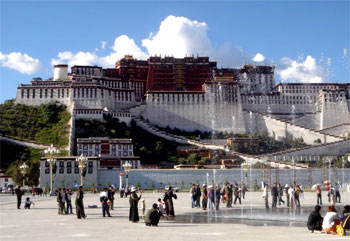| The Potala Palace was built 1,300 years ago in Tang Dynasty (618-907AD) when the Tibetan King Songtsam Gambo married the Tang Princess Wencheng. Potala is the name of the place, which means residence of the Goddess of Mercy in Tibetan language. The palace is more than 117 meters (384 feet) in high and 360 (1180 feet) wide, occupying a building space of 90 thousand square meters. Potala Palace has two parts. One is White Palace, which is for secular use, and the other is Red Palace, which is for religious use.
Potala Palace - White Palace
The White Palace consists of offices, dormitories, a Buddhist official seminary, and a printing house. In the White Palace, you can see three ladder stairs reaching inside of it. The central one was reserved for only Dalai Lamas and central government magistrates dispatched to Tibet. In the first hallway, many huge murals are hanging on the wall. They described the construction of Potala Palace and Jokhang Temple and the procession of Princess Wencheng reaching Tibet. On the south wall, visitors can see an edict signed with the Great Fifth's handprint. The White Palace mainly serves as the political headquarter and Dalai Lamas' living quarters.

Potala Palace - Red Palace
It was constructed after the death of the Fifth Dalai Lama. There are also some murals hung on the wall. By visiting them, you will know the Great Fifth Dalai Lama’ life. In the center of the Red Palace, you can see a hall; we called it the Great West Hall.
In the hall, there are four additional chapels. In the West Chapel, there are three gold stupas. They belonged to the Fifth, Tenth and Twelfth Dalai Lama. Their mummified and perfumed bodies are well kept in those stupas. Among them, the Fifth Dalai Lama's stupa is the biggest and it is made of sandalwood, wrapped in gold foil and decorated with thousands of diamonds, pearls, agates and others gems. The North Chapel contains statues of Sakyamuni, Dalai Lamas and Medicine Buddha, and stupas of the Eighth, Ninth and Eleventh Dalai Lamas. In the East Chapel, there is a two meters (6.5 feet) high statue of Tsong Khapa. He is the founder of Gelugpa. The South Chapel is a silver statue of Padmasambhava and 8 bronze statues of his reincarnations.
In the west of the Hall locates the Thirteenth Dalai Lama's stupa hall. Because he was regarded as great as the Great Fifth, people started to build his stupa after his death in the fall of 1933. It is 14 meters (46 feet) in height, coated with a ton (2200 pounds) of gold foils. In front of it is a mandala made of more than 200,000 pearls and other gems. Murals in the hall tell important events in his life, including his visit with Emperor Guangxu. The highest hall of Potala was built in 1690. It used to be the holy shrine of Chinese Emperors. Dalai Lamas would come here with their officials and high lamas to show their respects to the central government.
Dharma Cave and the Saint's Chapel were built in seventh century. They are the only structures left. They both lie central of the Red Palace. Dharma Cave is said to be the place where King Songtsen Gampo proceeded his religious cultivation. Inside the cave, statues of Songtsen Gampo, Princess Wencheng, Princess Tritsun and his chief ministers are enshrined. In the Saint's Chapel above Dharma Cave, Chenrezi, Tsong Khapa, Padmasambhava, the Fifth, Seventh, Eighth and Ninth Dalai Lamas are enshrined and worshipped. Visitors may find a stone with a footprint that was believed left by the infant Twelfth Dalai Lama.
In December 1994, the Potala Palace of Lhasa was put on the UNESCO's list of World Cultural Heritage. It is a symbol of the wisdom of the Tibetan people. |